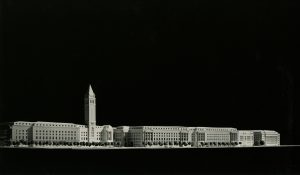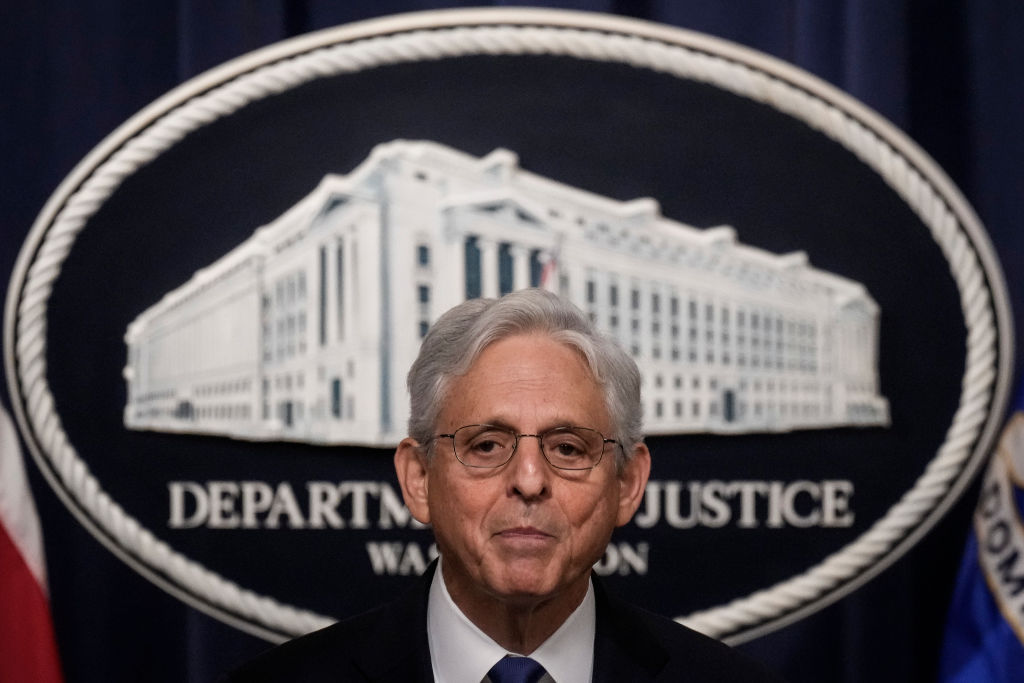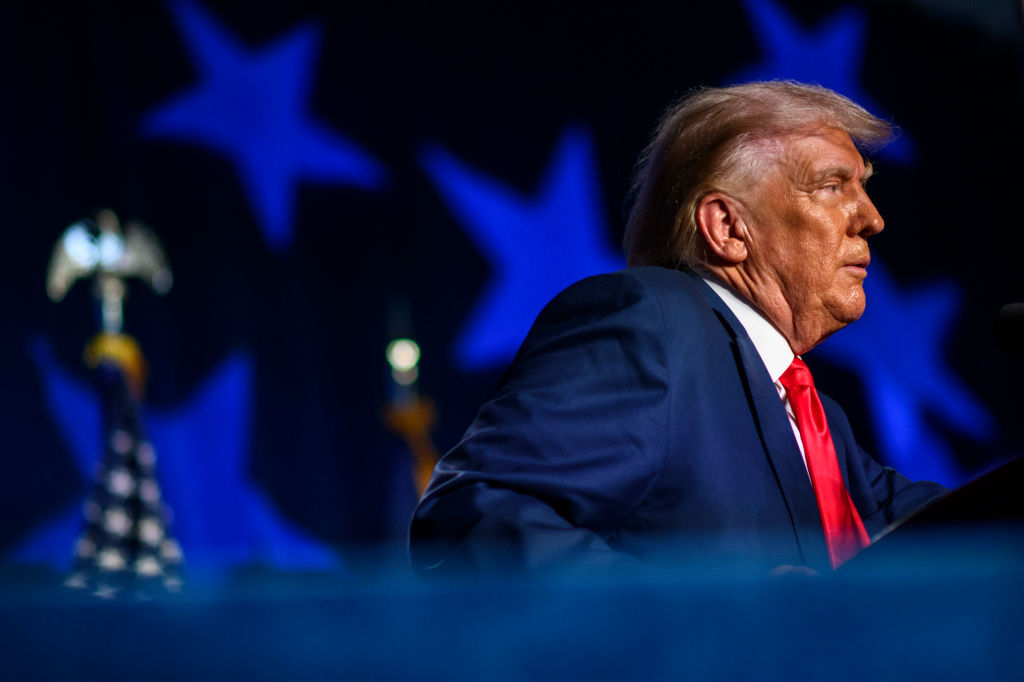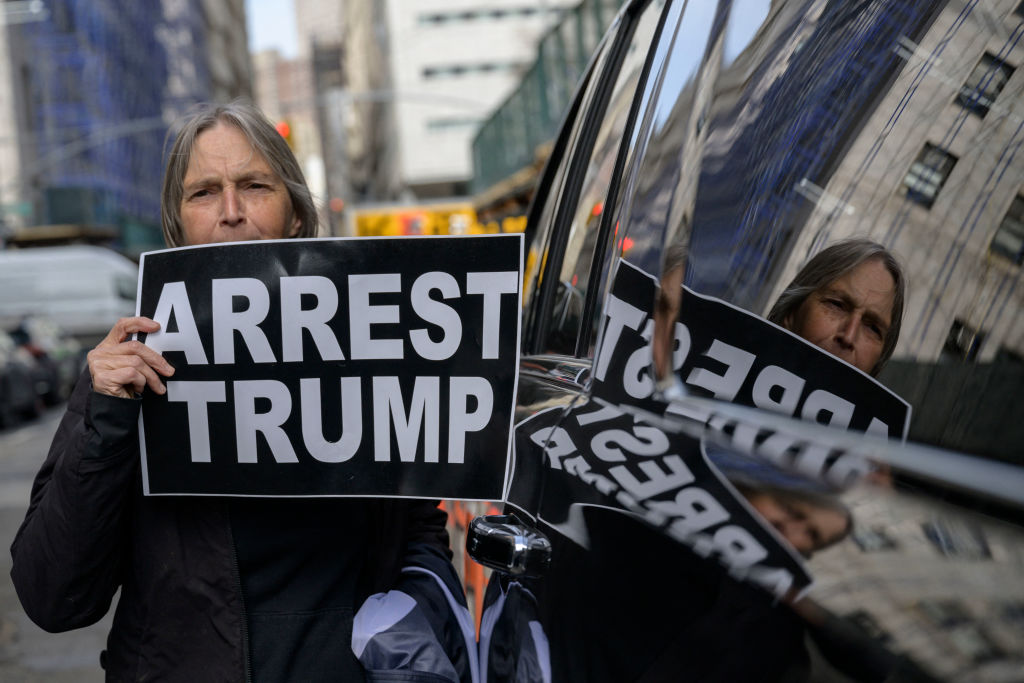What might it actually look like to represent the real interests and values of most voters?
The Classical D.C. That Wasn’t

Would Daniel Patrick Moynihan have agreed with Trump?
Half a century ago, a young architect in the office of Vincent G. Kling Associates, a successful Philadelphia firm, produced a magnificent plan for the completion of the classical Federal Triangle. Situated immediately north of the Mall in Washington, the 75-acre complex of government buildings had been erected during the 1920s and ’30s. The Depression had prevented its completion.
The architect was Alvin Holm, who had studied with the modernist painter Joseph Albers as a Yale undergrad and then the noted modernist architect and planner G. Holmes Perkins at Penn. Curiously, the classical mandate came from Kling, also a modernist. “Jaws dropped,” Holm recalls, at a convocation of Washington planning officials when Kling announced his idea. But he got the green light.
Holm’s 1969 project warrants notice as the Trump White House considers a draft executive order that would designate classical and other traditional architectural idioms as “preferred styles” for federal courthouses and office buildings—and elevate the classical to the “default” idiom for our nation’s capital. Such an executive order, should President Trump sign it, would end, or at least interrupt, the modernist dark age in Uncle Sam’s architectural history that spans the entire postwar period.
Needless to say, the American Institute of Architects and the rest of the modernist establishment is experiencing a collective meltdown over this challenge to their cultural hegemony. Many classicists, too, are giving short shrift to the appropriateness of such a mandate. The simple truth is that classicism has yielded a far higher return on Uncle Sam’s architectural investments than any other approach to design. Apart from the widely reviled Brutalist and Deconstructionist modes, the proposed order does not ban modernist architecture. It simply establishes sensible criteria based on decades of accumulated experience.
Despite his training, Holm came up with a design that completed the Triangle without rupture in stylistic consistency, employing the same formal vocabulary of pedimented porticos, pilasters, and arcades. The operative criterion was building on an existing sense of place, not expressing some threadbare notion of the spirit of the age. Holm would have implemented the original Triangle plan through the demolition of the old Romanesque Post Office building (1899) on Pennsylvania Avenue, now home to the Trump International Hotel.

In Holm’s plan, however, this building’s campanile—a beloved Washington landmark—was astutely retained. Removal of the old Post Office would allow construction of the originally intended hemicyclical edifice to complete the IRS building and echo the existing classical architectural hemicycle across 12th Street—then known as the New Post Office building and now home to the Environmental Protection Agency.
Further west, Holm would have done away with an undistinguished and long-since-demolished structure next to Washington’s august City Hall (now the John A. Wilson Building) on Pennsylvania Avenue. He would then have inserted an annex to the classical Post Office edifice in harmony with both its neighbors. And he would have replaced the huge parking lot behind the City Hall with a beautifully landscaped plaza featuring a fountain and cascades, with structured parking as well as pedestrian access to the planned Federal Triangle Metro station below ground.
Holm’s classicism was focused on the public realm. His interiors were modernist.
A Gift to Modernism, a Blow to the Nation
It is the nation’s great misfortune that this plan was never executed, possibly on account of the fiscal toll taken by the Vietnam War or possibly on account of misguided preservationist sentiment regarding the Old Post Office. Holm’s is by far the most enlightened development plan commissioned by the federal government since World War II. It could have established an alternative paradigm for the nation’s public architecture revolving around the ideal of cultural continuity instead of the rejection of an architectural heritage extending back in time for thousands of years.
Holm’s plan figures not at all, as far as I know, in the art-historical literature, aside from its inclusion in the endlessly fascinating architectural history of our nation’s capital compiled by the U.S. Commission of Fine Arts in a weighty tome, Civic Art (2013). As for Holm, he became a leading classical convert and during the 1990s designed the galleries devoted to 19th-century academic art at the Metropolitan Museum in New York.
Which brings us to Daniel Patrick Moynihan, who as a young Kennedy Administration aide drafted a report concerning an acute shortage of federal office space. Moynihan ventured to include his thoughts on the importance of improving Pennsylvania Avenue, whose north side, across from the Triangle, was in dilapidated condition. Jacqueline Kennedy subsequently secured President Johnson’s commitment to take action on the avenue in a meeting shortly after JFK’s assassination.
Moynihan also appended “Guiding Principles for Federal Architecture” to his report. So far as architectural esthetics are concerned, the Guiding Principles’ two crucial stipulations came in consecutive sentences:
The development of an official style must be avoided. Design must flow from the architectural profession to the government, and not vice-versa.
In order to secure architecture expressive of “the dignity, enterprise, vigor, and stability of the American National Government,” Moynihan asserted, the government must commission “designs that embody the finest contemporary American architectural thought.”
Up to this point, classicism had been the federal government’s official idiom for most of the nation’s history. But Moynihan’s Guiding Principles of 1962 were a gift to the modernist establishment, even though they lack the force of law. And they have yielded very little in the way of architecture—or planning, another concern of Moynihan’s—expressive of the federal government’s “dignity, enterprise, vigor and stability.”
Holm produced his Triangle plan five years after Nathaniel Owings, a co-founder of the giant corporate-modernist architecture firm, Skidmore Owings and Merrill, conceived a pharaonic scheme for Pennsylvania Avenue. At the west end, next to the Treasury Department, Owings’s plan was anchored by a National Square of vastly inhuman dimensions. The venerable Willard and Washington Hotels would have been history.
Owings’s square was to be bordered to the north by a humongous retail-and-office building modeled on Moscow’s GUM Department Store. Imposing but depressingly sterile and monotonous architecture was proposed for the avenue’s north side. (In fairness, however, it should be noted that Holm’s Triangle design followed Owings’s site planning for the complex’s completion.)
Owings’s 1964 plan was of course never realized either. Jane Jacobs’s The Death and Life of Great American Cities had been published in 1961 and it generated mounting resistance to such “cataclysmic” redevelopment. The cataclysmic Pennsylvania Avenue plan’s simplistic high-modernist aesthetic was steadily diluted over time.
Redevelopment along the avenue in the following decades instead produced an architectural mish-mash that hardly testifies to the wisdom of allowing the architectural profession to call the stylistic shots. The most important building to result from the project was the consummately Brutalist and supremely hideous J. Edgar Hoover FBI headquarters (1975).
What Might Have Been
Decades after drafting the Guiding Principles, Moynihan spoke of having Mies van der Rohe’s sleek Seagram Building (1958) on Manhattan’s Park Avenue in mind. The “Whiskey Trust,” he averred, could be relied on as an architectural tastemaker. But the Seagram is high-end corporate architecture, not civic architecture. And Mies’s reductionism doesn’t lend itself to widespread reiteration. It gets old, fast.
What’s more, the general quality of buildings modernist General Services Administration bureaucrats built during the decades following the Guiding Principles’ promulgation was decidedly sub-Miesian: anodyne and generic office-building boxes alternating with sculpturesquely Brutalist structures. Later, after GSA launched its Design Excellence program in 1994, came a host of even more pretentiously unsightly edifices.
Moynihan abhorred the admittedly bland classicism of the Rayburn House Office Building, completed around the time he drafted the Guiding Principles. But he was also scathingly disdainful of the modernist Hart Senate Office Building completed two decades later. “Twentieth-century America,” he wrote in 1970, “has seen a steady, persistent decline in the visual and emotional power of its public buildings, and this has been accompanied by a not less persistent decline in the authority of the public order.”
There’s no evidence he ever reversed that judgment. Moynihan’s good friend Nathan Glazer, in his book on modernist architecture, From a Cause to a Style (2007), says he believes Moynihan, who died in 2003, was put off by the theatrics of latter-day contemporary architects, but kept his opinions to himself.
On the other hand, Moynihan was evidently taken with the classical, and hemicyclical, Market Square mixed-use development (1990) that faces and complements John Russell Pope’s magisterial National Archives across Pennsylvania Avenue. This hemicycle is bisected by Eighth Street, opening up a vista terminated by the majestic portico of Robert Mills’s old Patent Office, now the Smithsonian American Art Museum. Market Square is by far the most successful component of Pennsylvania Avenue’s redevelopment. When condominiums in the complex went on the market, Moynihan, who loved traditional architecture, was at the front of the line.

He also avidly promoted the rather less impressive complex that wound up completing the Triangle, the Ronald Reagan Building and International Trade Center (1998), a 3.1 million-square-foot behemoth designed in an unsatisfying, classically-derived postmodern idiom. Particularly disappointing is the way the architect, James Ingo Freed, failed to echo the western EPA building hemicycle, conjoined with the east-facing one mentioned above. Instead he created an utterly disfigured space that simply does not attract people.
The contrast with Holm’s 1969 plan could hardly be more pronounced.
At the time Holm produced his Federal Triangle plan, Moynihan was an urban affairs counselor to President Nixon. It is well known that he urged the president to take an interest in Pennsylvania Avenue’s redevelopment, and that Nixon was very responsive.
It is also well known that Moynihan was an extremely smooth bureaucratic operator. And he was not one to pick fights with cultural elites supporting the modernist dispensation. Did he quietly direct Holm’s modernist boss to produce a classical plan for the Triangle’s completion? Holm says he never heard Kling mention such a thing, and it is admittedly highly unlikely.
But I can’t help thinking Moynihan would have been very impressed with Holm’s plan had he seen it, especially taking into account the very unimpressive modernist visions for Pennsylvania Avenue’s northern flank.
As for the proposed executive order, Moynihan—were he with us today—probably would still oppose any White House directive suggestive of an “official style,” especially one issued in an intensely polarized political climate. (Holm himself shares that political concern.) But Moynihan certainly would have been attuned to the elite cultural dysfunction that has brought us to this pass. The truth is that sane cultural disruption, where the design of our federal courthouses and office buildings is concerned, is long overdue.
The American Mind presents a range of perspectives. Views are writers’ own and do not necessarily represent those of The Claremont Institute.
The American Mind is a publication of the Claremont Institute, a non-profit 501(c)(3) organization, dedicated to restoring the principles of the American Founding to their rightful, preeminent authority in our national life. Interested in supporting our work? Gifts to the Claremont Institute are tax-deductible.
The indictments of Donald Trump are tissue thin and intended only to harass him and disrupt the 2024 election.
Efforts to sow confusion and chaos in our election systems must be confronted.
The indictments of Donald Trump represent a power play, not the interests of justice.
Too often, experts who are working to "save American democracy" are doing anything but.
A government agency seeks to delegitimize conservative politics.






